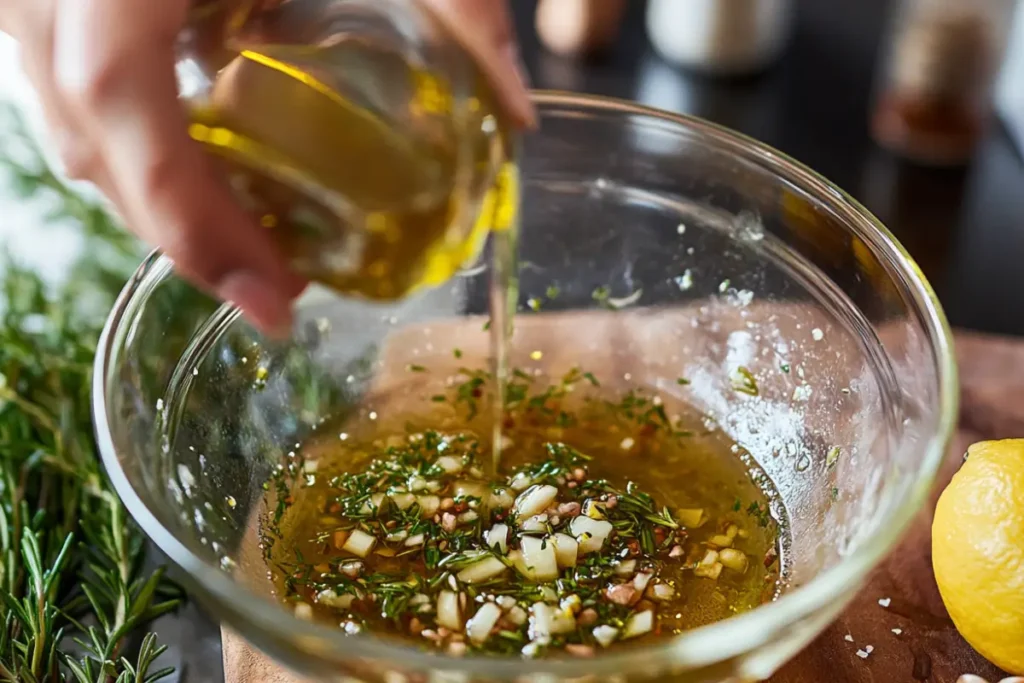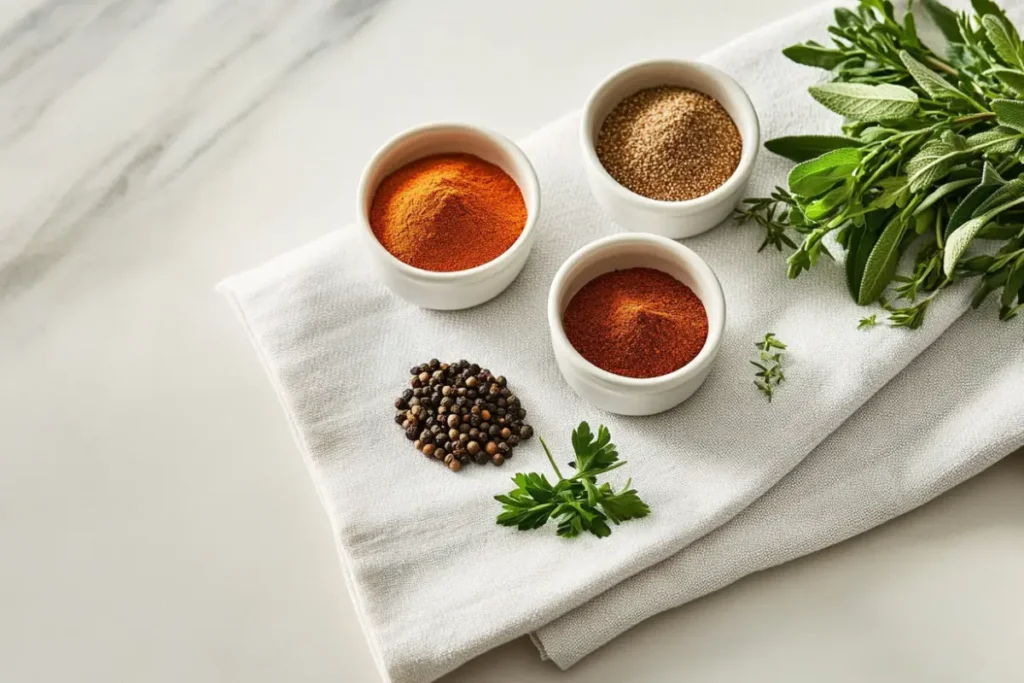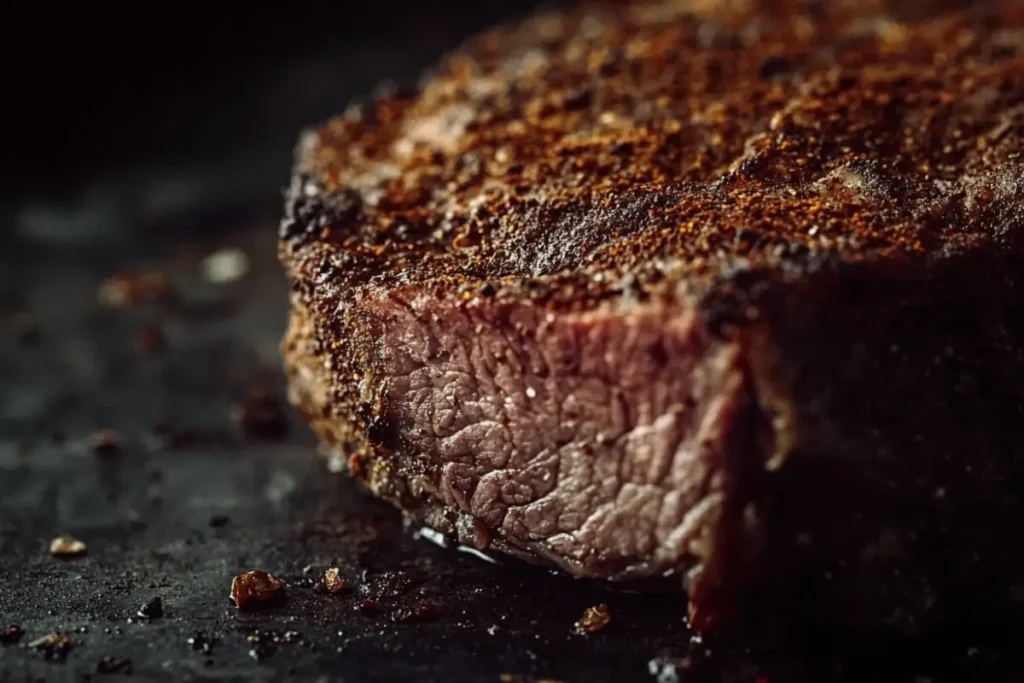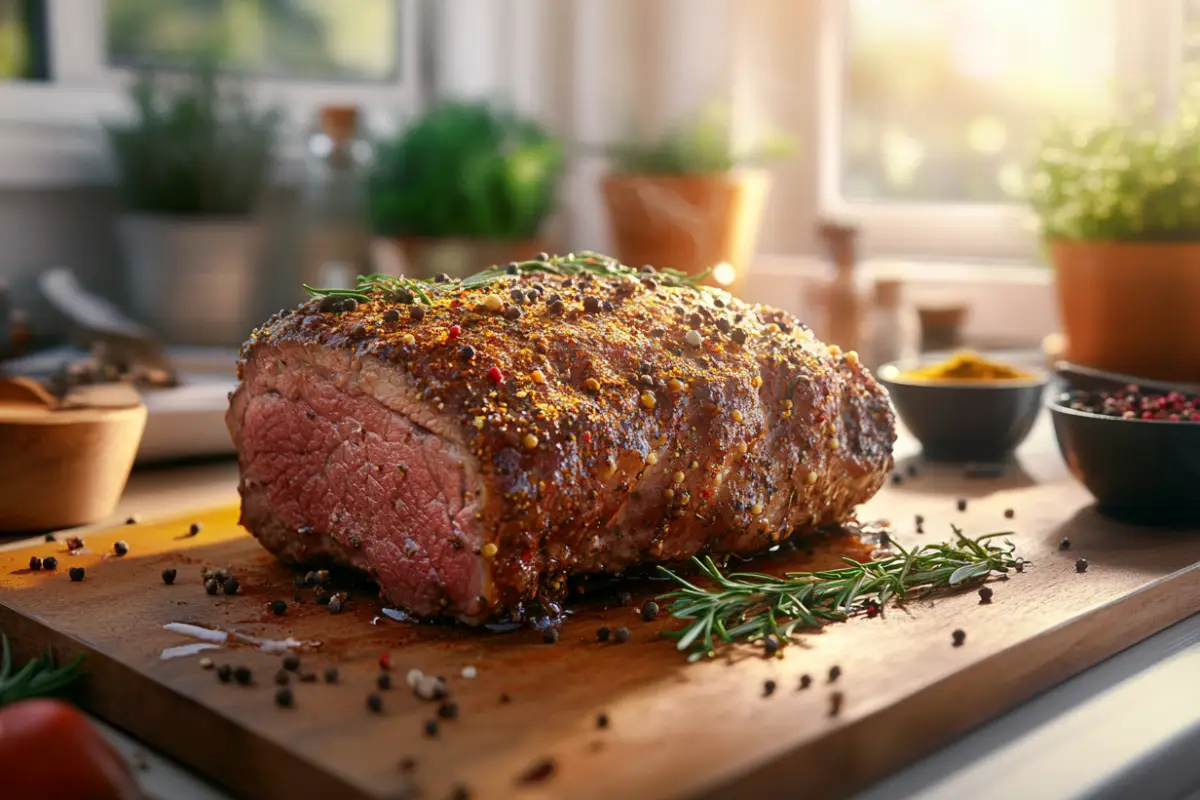Last Updated on January 17, 2025 by Souhail
Roast beef is a timeless classic, but the secret to making it truly unforgettable lies in the seasonings. Wondering what herbs and spices go best with roast beef? From the earthy aroma of rosemary to the smoky depth of paprika, the right combinations can elevate your roast to a whole new level. Whether it’s for a holiday feast or a comforting family dinner, choosing the perfect seasonings transforms a simple cut of beef into a flavorful masterpiece that everyone will love.
In this article, we’ll delve into the best herbs and spices for roast beef, exploring their unique characteristics, how they complement the meat, and creative combinations to try. From classic pairings to modern twists, you’ll discover everything you need to create a flavorful masterpiece.
Table of contents
- 1. Why the Right Seasonings Matter
- 2. Classic Herbs for Roast Beef
- 3. Bold Spices to Elevate Roast Beef
- 4. Creative Herb and Spice Blends
- 5. Pairing Herbs and Spices with Different Cuts of Beef
- 6. Pro Tips for Using Herbs and Spices on Roast Beef
- 7. Top Marinades for Roast Beef
- 8. Regional and Cultural Spice Blends for Roast Beef
- 9. Mistakes to Avoid When Seasoning Roast Beef
- FAQs
- Final Toughts
1. Why the Right Seasonings Matter
Herbs and spices are the soul of any roast beef recipe. They not only amplify the flavor but also help create an inviting aroma and a beautifully caramelized crust. By experimenting with different combinations, you can craft a dish that feels entirely your own—whether it’s a traditional Sunday roast with rosemary and thyme or a smoky, paprika-spiced creation.
2. Classic Herbs for Roast Beef
Rosemary
Rosemary is one of the most iconic herbs for roast beef. Its woody aroma and pine-like flavor pair beautifully with the meat’s natural richness. When roasted, rosemary’s oils are released, infusing the beef with a warm, earthy fragrance.
- Pro Tip: Use fresh sprigs of rosemary and tuck them under the roast or scatter them in the roasting pan for maximum flavor.
Thyme
Thyme is another staple herb for roast beef, offering a subtle, slightly minty flavor with earthy undertones. It enhances the savory notes of the beef without overpowering it.
- Pro Tip: Combine thyme with garlic and olive oil to create a flavorful rub.
Bay Leaves
Bay leaves impart a mild, slightly floral flavor that works as a background note in roast beef dishes. While not as bold as rosemary or thyme, they add depth and complexity.
- Pro Tip: Add a few dried bay leaves to the roasting liquid or beef stock used for basting.
3. Bold Spices to Elevate Roast Beef
Black Pepper
A coarse grind of black pepper is essential for roast beef. Its spicy, pungent flavor creates a perfect crust on the meat when combined with salt.
- Pro Tip: Use freshly ground pepper for the most robust flavor and texture.
Garlic Powder
Garlic powder brings a concentrated, savory kick to roast beef. While fresh garlic works well, the powder ensures even distribution across the surface.
- Pro Tip: Combine garlic powder with salt, pepper, and paprika for a simple, flavorful rub.
Smoked Paprika
For a hint of smokiness and mild sweetness, smoked paprika is a must-try. It enhances the beef’s natural umami flavors while adding a vibrant red hue.
- Pro Tip: Blend smoked paprika with olive oil for a marinade or rub it directly onto the meat.
Mustard Powder
Mustard powder adds a sharp, tangy bite to roast beef, balancing its richness. It’s particularly effective when used in crusts or marinades.
- Pro Tip: Mix mustard powder with water to form a paste, then spread it over the roast before cooking.
4. Creative Herb and Spice Blends
Herbes de Provence
This French herb blend typically includes thyme, rosemary, oregano, and lavender. It provides a floral, slightly sweet flavor that complements roast beef beautifully.
- Pro Tip: Sprinkle Herbes de Provence generously over the meat before roasting for a fragrant, Mediterranean-inspired dish.
Cajun Spice Mix
For a bolder, spicier roast beef, try a Cajun spice mix. With ingredients like paprika, cayenne, and garlic powder, it adds a zesty kick.
- Pro Tip: Adjust the cayenne level to control the heat.
Italian Seasoning
A mix of basil, oregano, and parsley, Italian seasoning gives roast beef a savory, herbaceous profile. It’s a great choice for pairing with tomato-based sauces.
- Pro Tip: Use Italian seasoning in your marinade or mix it with breadcrumbs for a crusty topping.
5. Pairing Herbs and Spices with Different Cuts of Beef
Chuck Roast
Chuck roast benefits from robust seasonings like garlic, black pepper, and rosemary, as its rich marbling absorbs bold flavors.
Ribeye Roast
The ribeye’s natural juiciness pairs well with simple combinations, such as salt, pepper, and thyme, to let the meat shine.
Sirloin Tip Roast
A leaner cut like the sirloin tip roast works well with bolder, more complex blends, such as mustard powder, smoked paprika, and Italian seasoning.
6. Pro Tips for Using Herbs and Spices on Roast Beef
- Fresh vs. Dried: While fresh herbs offer brighter flavors, dried herbs are more concentrated and work better for long roasting times. Use a mix of both for depth.
- Even Coating: For a perfect crust, coat the roast evenly with your herb and spice mixture, pressing it into the meat to help it stick.
- Marinating for Flavor: Marinate the beef with olive oil, garlic, and your choice of herbs and spices for at least two hours—or overnight—for maximum infusion.
- Don’t Overdo It: Let the beef’s natural flavors shine by using herbs and spices to enhance rather than mask the meat.
7. Top Marinades for Roast Beef

Marinating roast beef is a fantastic way to infuse flavor deep into the meat while tenderizing it at the same time. A good marinade often combines acidity, fat, and seasoning, creating a balance that enhances the beef’s natural richness. Here are some top marinade ideas to try:
Herb-Based Marinades
- Garlic-Rosemary Marinade: Combine olive oil, minced garlic, chopped fresh rosemary, lemon juice, salt, and pepper. This classic combination adds a fragrant, earthy flavor.
- How to Use: Marinate for at least 4 hours or overnight for the best results.
- Parsley-Lemon Marinade: A light, zesty option with finely chopped parsley, lemon zest, olive oil, and a touch of Dijon mustard.
- Best for: Leaner cuts like sirloin tip roast or eye of round.
Spicy and Smoky Marinades
- Chipotle-Cumin Marinade: A smoky, spicy mix of chipotle peppers in adobo sauce, ground cumin, smoked paprika, and lime juice.
- Pro Tip: This works wonderfully on fattier cuts like chuck roast, as the spices balance the richness.
- Cajun-Style Marinade: A bold mix of Cajun seasoning, olive oil, garlic powder, and a splash of Worcestershire sauce.
- Pair With: Roast beef for sandwiches or tacos.
Sweet and Tangy Marinades
- Balsamic-Honey Marinade: A rich blend of balsamic vinegar, honey, soy sauce, and fresh thyme. The sweetness caramelizes during roasting, creating a beautiful crust.
- Best for: Ribeye roast or other premium cuts.
- Pomegranate-Molasses Marinade: This Middle Eastern-inspired marinade features pomegranate molasses, garlic, cumin, and olive oil.
- Flavor Profile: Tangy and slightly sweet with deep umami notes.
8. Regional and Cultural Spice Blends for Roast Beef

Exploring the world of spices can introduce exciting new dimensions to your roast beef. Each region brings unique flavor profiles that tell a story through their ingredients.
French-Inspired Seasoning
- Herbes de Provence: A fragrant blend of thyme, rosemary, oregano, marjoram, and lavender.
- Why It Works: These herbs lend a floral and herbaceous quality that pairs perfectly with the beef’s umami.
- Tip: Combine with olive oil and a touch of Dijon mustard for a signature French twist.
Middle Eastern Spices
- Za’atar: A mix of thyme, sesame seeds, sumac, and sometimes oregano.
- Flavor Profile: Nutty, tangy, and slightly herbal.
- How to Use: Rub directly onto the beef with olive oil or mix into a marinade.
- Baharat: A warm blend of spices like cinnamon, cardamom, nutmeg, and coriander.
- Pro Tip: Sprinkle this on roast beef for a warm, aromatic crust.
Asian-Inspired Flavors
- Five-Spice Powder: A blend of star anise, cloves, cinnamon, fennel, and Sichuan peppercorns.
- Best For: Pairing with soy-based marinades or creating a crust for slow-roasted beef.
- Ginger-Soy Marinade: Soy sauce, fresh ginger, garlic, and a splash of rice vinegar create a savory, umami-packed roast.
Mexican-Inspired Blends
- Adobo Spice Rub: A bold mix of chili powder, cumin, oregano, and garlic.
- Flavor Profile: Smoky, earthy, and spicy.
- Serving Idea: Great for roast beef tacos or nachos.
9. Mistakes to Avoid When Seasoning Roast Beef
Even the best intentions can lead to seasoning missteps that diminish the final dish. Here are some common mistakes to avoid when seasoning roast beef:
Over-Seasoning the Meat

- Why It’s a Problem: Too much seasoning can overwhelm the natural flavor of the beef.
- How to Avoid It: Use a light hand with strong spices like cayenne or cloves, and focus on enhancing rather than masking the beef’s flavor.
Under-Seasoning Before Cooking
- The Risk: Roast beef can taste bland if it isn’t properly seasoned before it goes into the oven.
- Solution: Season the beef generously with salt and spices at least 30 minutes before cooking to allow the flavors to penetrate.
Skipping the Resting Time
- Why It Matters: Allowing the seasoned beef to rest after cooking ensures that the juices redistribute and the seasoning sets.
- Pro Tip: Let the roast rest for at least 15–20 minutes before slicing.
Not Using Fresh Ingredients
- Mistake: Using old, stale herbs and spices can result in muted flavors.
- How to Fix It: Check the freshness of your spices regularly and replace dried herbs after 6–12 months.
Ignoring the Cut of Beef
- What Happens: Certain cuts require different seasoning approaches due to their fat content and texture.
- Example: A fatty ribeye can handle bolder spices like cayenne and smoked paprika, while a lean sirloin roast benefits from tenderizing marinades.
Failing to Taste as You Go
- Why It’s Important: Without tasting your spice rubs, marinades, or sauces, you risk an unbalanced flavor profile.
- Fix: Always sample your seasoning mixtures before applying them to the meat.
Neglecting the Surface Area
- Mistake: Failing to evenly coat the beef with seasoning can lead to inconsistent flavors.
- Pro Tip: Massage the herbs and spices into every crevice of the roast for uniform flavor.
FAQs
Rosemary, thyme, garlic, black pepper, smoked paprika, and mustard powder are top choices for enhancing roast beef.
Both work well! Fresh herbs add brightness, while dried herbs are more concentrated and better for long roasting.
Rub the spices evenly over the beef’s surface or mix them with oil for a marinade to ensure full coverage and flavor.
Yes, marinating overnight allows flavors to penetrate the meat, resulting in a more flavorful and tender roast.
Herbes de Provence, Cajun spice mix, za’atar, and Italian seasoning are excellent blends to try.
Yes, too much seasoning can overpower the beef’s natural flavor. Use bold spices sparingly and balance flavors carefully.
Final Toughts
Crafting the perfect roast beef is an art, and choosing the right herbs and spices is the secret to success. Whether you prefer classic flavors like rosemary and thyme, or bold twists like Cajun or smoked paprika, the possibilities are endless. By understanding how different seasonings interact with the meat, you can elevate your roast beef from ordinary to extraordinary.
So, next time you’re planning a roast beef dinner, don’t hesitate to experiment. Try new combinations, add a personal touch, and let your creativity shine. Your family and guests will thank you for the flavorful masterpiece on their plates!
For even more seasoning inspiration, don’t miss our article on The Best Pot Roast Seasoning Recipe for Flavorful Perfection. It’s packed with tips and ideas to help you create a tender, flavorful pot roast that’s sure to impress. Check it out and elevate your cooking game!

